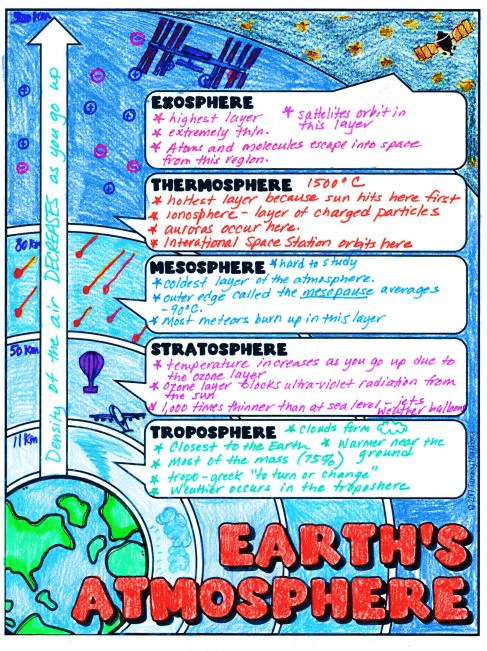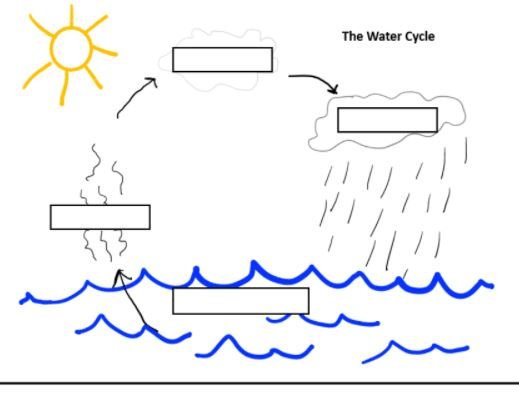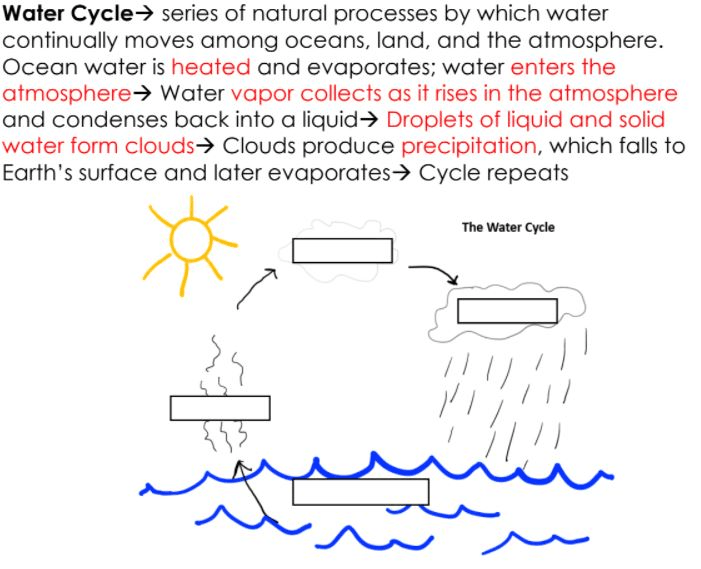A thin layer of gases surrounding the Earth is ________.
What is Atmosphere?
A layer of the atmosphere closest to Earth's surface, warmest ________.
What is Troposphere?
Weight of the earth's atmosphere pressing down upon its surface is ______.
What is air pressure?
The movement of air from areas of high pressure to areas of low pressure are ______.
What are winds?
Driven by Sun and Gravity, Water changes its state as it moves through the multiple pathways of the hydrologic cycle.
What is the Water Cycle?
A state of the atmosphere at a certain place at a specific time is ________.
What is the weather?
____________ flow from regions of high pressure to low pressure, causing weather.
What are air masses?
___________ an intense local storm that forms along strong winds, heavy rain, lightning, thunder, & sometimes hail
What are Thunderstorms?
The average temperature, precipitation, humidity, air pressure, and wind in a specific place over time is ______.
What is Climate?
The most abundant gas in the atmosphere is _______.
What is Nitrogen?
Most meteors burn up here.
What is the Mesosphere?
Force that pulls all objects to earth.
What is gravity?
Are cold winds that blow from the east to the west near the North & South Pole.
What are polar easterlies?
The movement of particles during the water cycle is an example ________.
What is kinetic Energy?
Temperature and rainfall, air pressure, wind speed and direction, humidity, cloud coverage
What are Variables?
Large body of circulating air with low pressure at its center and higher pressure outside of the system is _________________.
What is Low-pressure systems?
_________ a violent, whirling column of air in contact with the ground
What are Tornadoes?
Climate is based on __________ & _____________.
What is average temperature and precipitation?
Excess of this gas contributes to global warming is __________.
What is Carbon Dioxide?
Farest from Earth's surface, satellites circle Earth here.
What is Exosphere?
Oxygen _______ as altitude _______.
What are decreases and increases?
Steady winds that flow from west to east between
latitudes 30° N and 60° N, and 30° S and 60° S.
What are Westerlies?
Physical change in matter from a liquid to a gas is ______.
What is Evaporation?
Measure of the average kinetic energy of molecules in the air
What is Air temperature?
_____________ is large body of circulating air with high ressure at its center and low pressure outside of the system. Air moves from high to low pressure bringing clear skies and fair weather.
What is High-pressure systems?
___________ is cold air blowing southward from Canada collides with warm, moist air from the Gulf of Mexico.
What is Tornado Alley?
Gas in the atmosphere that we breathe in _______.
What is Oxygen?
Planes fly in this layer of the earth's atmosphere.
What is the stratosphere?
This changes within each layer of the atmosphere.
What is the temperature?
Winds steady winds that flow from east to west between 30° N latitude and 30° S latitude.
What is trade Winds?
Physical change in matter from a gas to a liquid is _____.
What is Condensation?
The force that a column of air applies on the air or a
surface below is _______>
What is Air Pressure?
A ________ is a boundary between two air masses
What is a Front?
_________ intense tropical storm with winds exceeding 199 km/h.
What are Hurricanes?
Earth's Atmosphere contains these fours things necessary for life on Earth. Name them.
What are nitrogen, oxygen, carbon dioxide, and water?
This protects us from solar radiation.
What is the ozone layer?
Tempareture _______ and altitude _______ in the troposphere. Temperature _______ and altitude _______ in the mesosphere.
What are decreases and increases? What are decreases and increases?
Calm area around the equator where very little wind blows is
What is the Doldrums?
Water that falls to the earth in solid (snow, hail) or
liquid (rain) form.
What is precipitation?
Temperature at which air is fully saturated because of decreasing temperatures while holding the amount of moisture constant. Like a sponge that is full of water before it starts dripping.
What is Dew Point?
_________ SINKS, cold mass moves to warmer mass, decrease temperatures, brings showers and thunderstorms
What are Cold Fronts?
_____________ use symbols, the history of natural hazards in a region, combined with an understanding of related geologic forces an help forecast the locations and likelihoods of future events.
What are weather maps?
Three Factors that affect climate are _______________.
What are: (any three)
Latitude
Altitude
Distance to a Body of Water
Ocean Currents
Topography
Prevailing Winds
Describe the greenhouse effect?
What is when the Sun's energy reaches the Earth's atmosphere, some of it is reflected back to space and some is absorbed and re-radiated by greenhouse gases.
A layer of charged atoms and molecules that reflect and transmit radio waves at ground level is known as
What is the Ionosphere?
Name the five layers in earth's atmosphere in order, and two facts about each one.

A change in the course of objects caused by the earth's rotation is _______.
What is the Coriolis Effect?
Explain the water cycle to me.


Water droplets or ice crystals suspended in the atmosphere are _______.
What are Clouds and Fog?
___________ RISES, warmer weather, more humid.
What are warm fronts?
Thermometers, barometers, anemometers, satellites, and Doppler radar are used to measure weather variables use these for ___________.
What is weather forcasting?
________ & __________ are influenced by interactions involving sunlight, the ocean, the atmosphere, ice, landforms, and living things.
What are weather and climate?